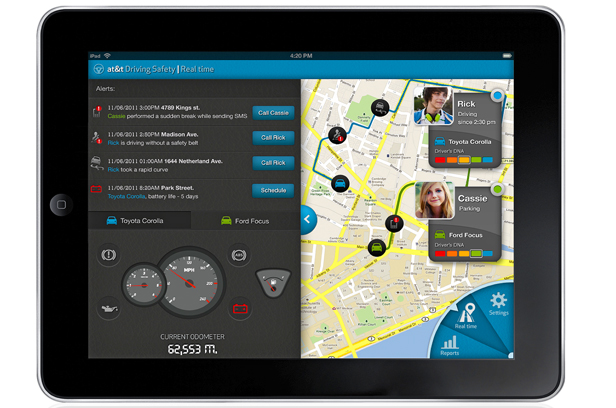App Tracks Your Teenager’s Driving Habits

By merging data from cars’ onboard computers and drivers’ smart phones, AT&T researchers have created a system that reports on drivers’ real-time behavior and long-term driving trends—and reveals whether a particular mistake might have been caused by phone use.
The company envisions the prototype system as a cloud-based chaperone for teen drivers. But it could rate any driver’s abilities, and any change in those abilities, over time. “It allows you, as a parent, to monitor kids’ driving behavior in real time. And if your kid is SMS-ing while driving, you will be able to log it—and even remotely disable the phone,” says Raz Dar, business manager at AT&T’s business incubator in Ra’anana, Israel. “The only thing he could do to prevent it is take out the unit from the car—unplug it—but we can detect that, too, and send an alert.”
It works like this: a device plugged into a car’s electronic diagnostic port inside the engine compartment beams out vehicle information such as speed, acceleration rate, steering, and braking—together with GPS coordinates. Meanwhile, an app on the phone beams out information on its usage.
Then, in an AT&T cloud, the two streams of information are analyzed, folding in additional information such as speed limits on the stretch of roadway involved. The result: alerts sent to the parent’s phone describing where the kid is, whether he is exceeding the speed limit, whether he’s wearing a seat belt, whether he has braked or steered abruptly, and whether he was talking or texting when those things happened.
The system is still a research project, and there is no announced timetable for commercialization. Ultimately, AT&T hopes to sell or license the system as a product, and also open up the cloud system for developers to create new apps such as tracking an elderly driver’s aptitude over time, says Dar.
The company also envisions a day when insurance companies offer a discount to drivers who submit to the monitoring and show themselves to be good drivers who don’t text while driving. Insurance companies have already started down this path. Progressive Insurance, for example, offers an optional Snapshot program that involves plugging a device into a car’s onboard diagnostic computer. The device measures in real time when drivers use the car, how far they drive, and how hard they hit the brakes. Drivers can get a discount of up to 30 percent—or, in two states, a rate hike if the news is bad.
The AT&T technology is the result of a collaboration between AT&T and an Israeli startup, Traffilog, that already provides drivers and fleet managers with real-time alerts on unsafe driving as well as periodic reports aimed at improving driver behavior and vehicle maintenance.
Keep Reading
Most Popular
Large language models can do jaw-dropping things. But nobody knows exactly why.
And that's a problem. Figuring it out is one of the biggest scientific puzzles of our time and a crucial step towards controlling more powerful future models.
How scientists traced a mysterious covid case back to six toilets
When wastewater surveillance turns into a hunt for a single infected individual, the ethics get tricky.
The problem with plug-in hybrids? Their drivers.
Plug-in hybrids are often sold as a transition to EVs, but new data from Europe shows we’re still underestimating the emissions they produce.
Stay connected
Get the latest updates from
MIT Technology Review
Discover special offers, top stories, upcoming events, and more.